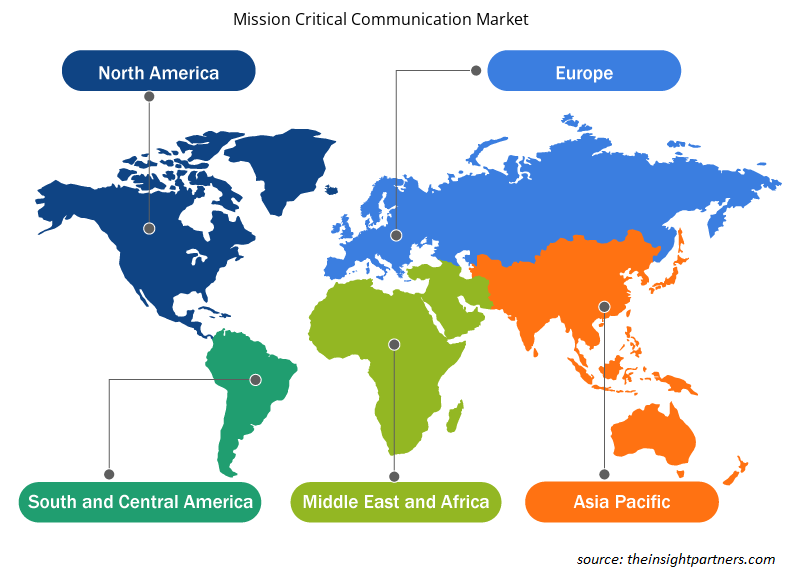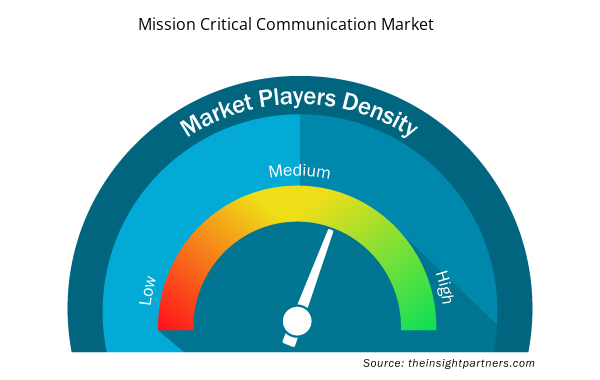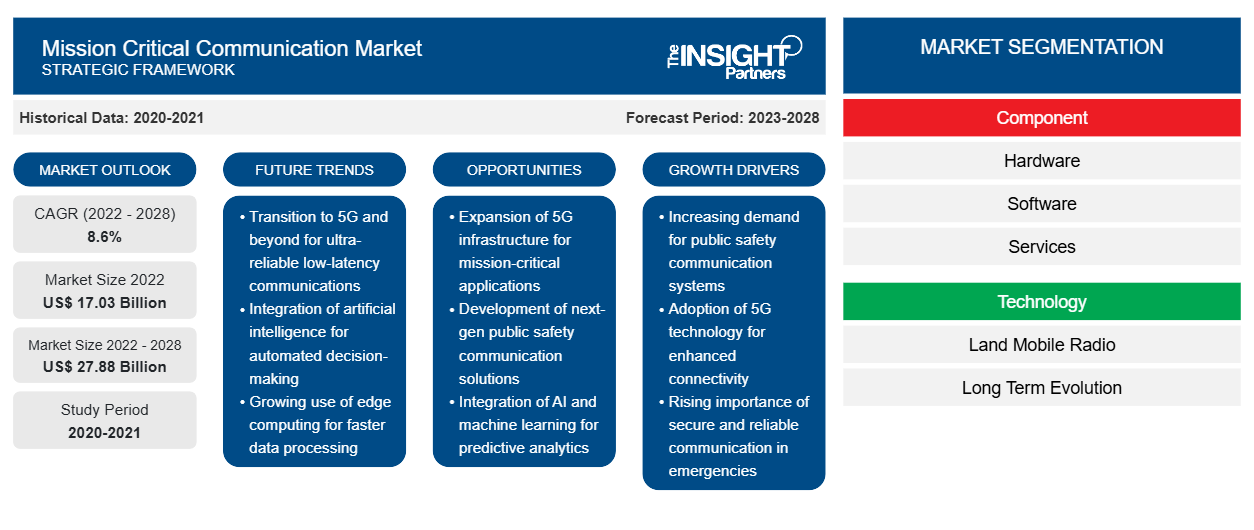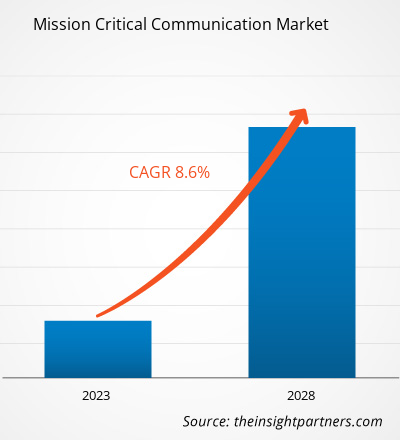ミッションクリティカル通信市場は、2022年の170億3,156万米ドルから2028年には278億7,668万米ドルに成長すると予想されており、2022年から2028年にかけて8.6%のCAGRで成長すると予測されています。
ミッションクリティカルな通信は、従来のネットワークがニーズに対応できない場合に通信手段を提供するために採用されるアプローチです。これは大規模な公共イベントでよく見られます。何千ものモバイル ユーザーが同時にネットワークを使用するため、ほとんどの公共通信ネットワークはそのような集中力を維持することができず、ダウンしてしまいます。従来の携帯電話ネットワークは、災害地域や公共の安全上の危機でも機能しなくなり、現場の緊急対応要員は通信システムを使用できなくなります。ミッションクリティカルな通信は、石油・ガス部門、沿岸警備隊、国土安全保障省、輸送業界、無人車両などでも重要です。
テロ、国境緊張、自然災害、対称戦争、反乱、大規模な緊急事態における国境を越えた通信、通信インフラの損傷、持ち上げ作業、閉鎖空間への進入、緊急対応などのさまざまな安全上重要なタスク、さまざまな関係者間の調整を確立する必要性などのケースが急増し、ミッションクリティカルな通信の需要が高まります。また、ミッションクリティカルなネットワークとインフラストラクチャシステムは、より優れたブロードバンド接続、モビリティ、相互運用性、およびセキュリティを提供します。
要件に合わせてレポートをカスタマイズする
このレポートの一部、国レベルの分析、Excelデータパックなど、あらゆるレポートを無料でカスタマイズできます。また、スタートアップや大学向けのお得なオファーや割引もご利用いただけます。
- このレポートの主要な市場動向を入手してください。この無料サンプルには、市場動向から見積もりや予測に至るまでのデータ分析が含まれます。
COVID-19パンデミックがミッションクリティカル通信市場に与える影響
COVID-19パンデミックは、サプライチェーン活動の混乱とパンデミック中の国際貿易への制限により、ミッションクリティカル通信市場の成長を妨げました。経済活動に不利な状況により、主要なミッションクリティカル通信ハードウェア製造拠点での操業が一時的に停止しました。その結果、いくつかの主要なコンポーネントサプライヤーとテクノロジープロバイダーは、コスト削減と製造活動の縮小に重点を移しました。しかし、電子機器の需要が途切れないため、ミッションクリティカル通信市場の成長に携わる企業は、2021年の回復期に操業を再開する可能性があります。
市場洞察 – ミッションクリティカル通信市場
ミッションクリティカル通信市場は、地域に基づいて、北米、ヨーロッパ、アジア太平洋 (APAC)、中東およびアフリカ (MEA)、南米 (SAM) に分割されています。ヨーロッパは 2021 年に最大の市場シェアを保持しましたが、アジア太平洋は予測期間中に最高の CAGR を記録すると予想されています。
欧州連合機関によると、サイバー攻撃の件数は2019年の432件から2020年には756件に増加しました。ミッションクリティカルな通信システムは、サイバー攻撃の検出と防止に重要な役割を果たします。BroadNet(欧州公共安全計画)は、国全体の安全を確保するために遠隔地から操作できる安全なミッションクリティカルなブロードバンド通信の導入に重点を置いています。したがって、サイバー攻撃の件数の増加に伴うセキュリティの脅威の高まりと、セキュリティ目的で高度な通信ソリューションを導入する政府の取り組みにより、今後数年間でヨーロッパのミッションクリティカルな通信市場シェアに有利な機会が生まれることが期待されます。
ヨーロッパでは、スウェーデン、オランダ、スイスなどの国々が、二酸化炭素排出量を削減するために発電所の開発に多額の投資を行っています。これらの要因は、市場の成長にさらに貢献しています。さらに、この地域での新たな製品の発売は、ミッションクリティカルな通信市場の成長をさらに促進すると予想されています。たとえば、2019年4月には、最近開設された410〜430MHz帯域で、ノキアとノルディックテレコムが世界初のミッションクリティカル通信(MCC)対応LTEネットワークを構築しました。チェコの通信事業者ノルディックテレコムは、ノキアの最先端かつ将来性のあるモバイルブロードバンドソリューションのおかげで、公共の安全と災害救助活動を加速することができます。このソリューションは、モバイルブロードバンドネットワークでのみ実現可能な新しいサービスを可能にします。上記の国々の産業発展は、ミッションクリティカルな通信市場の成長を促進するのに役立ちます。
テクノロジーに基づく洞察
技術に基づいて、ミッションクリティカル通信市場は陸上移動無線とLTEに分かれています。LTEセグメントは、2021年にミッションクリティカル通信の市場シェアを拡大しました。LTEは、携帯電話やその他のセルラーデバイスのネットワーク容量と速度を向上させる4Gワイヤレス規格です。低遅延と拡張可能な帯域幅容量に加えて、既存のグローバルモバイル通信システムおよびユニバーサルモバイル電気通信サービス技術との下位互換性があります。
ミッションクリティカル通信市場の規模は、コンポーネント、テクノロジー、垂直、および地理に基づいてセグメント化されています。コンポーネントに基づいて、ミッションクリティカル通信市場の規模は、ハードウェア、ソフトウェア、およびサービスに分類されています。テクノロジーに基づいて、市場分析は LTE と陸上移動無線に分かれています。垂直に基づいて、市場分析は、公共安全および政府機関、輸送、エネルギーおよび公共事業、鉱業、その他に分類されています。地理に基づいて、市場は主に北米、ヨーロッパ、アジア太平洋 (APAC)、中東およびアフリカ (MEA)、および南米に分割されています。
Telefonaktiebolaget LM Ericsson、Thales Group、Motorola Solutions、L3Harris Technologies, Inc.、Hytera Communications Corporation Ltd. などが、この市場における主要なプレーヤーの一部です。ミッションクリティカルな通信市場は、特定の地域に拠点を置く複数のプレーヤーによって非常に細分化されており、各プレーヤーは国内の需要に応えることに重点を置いています。
ミッションクリティカル通信市場の地域別分析
予測期間を通じてミッションクリティカル通信市場に影響を与える地域的な傾向と要因は、Insight Partners のアナリストによって徹底的に説明されています。このセクションでは、北米、ヨーロッパ、アジア太平洋、中東およびアフリカ、南米および中米にわたるミッションクリティカル通信市場のセグメントと地理についても説明します。

- ミッションクリティカルコミュニケーション市場の地域別データを入手
ミッションクリティカルコミュニケーション市場レポートの範囲
| レポート属性 | 詳細 |
|---|---|
| 2022年の市場規模 | 170.3億米ドル |
| 2028年までの市場規模 | 278.8億米ドル |
| 世界のCAGR(2022年 - 2028年) | 8.6% |
| 履歴データ | 2020-2021 |
| 予測期間 | 2023-2028 |
| 対象セグメント | コンポーネント別
|
| 対象地域と国 | 北米
|
| 市場リーダーと主要企業プロフィール |
|
市場プレーヤーの密度:ビジネスダイナミクスへの影響を理解する
ミッション クリティカル コミュニケーション市場は、消費者の嗜好の変化、技術の進歩、製品の利点に対する認識の高まりなどの要因により、エンド ユーザーの需要が高まり、急速に成長しています。需要が高まるにつれて、企業は提供内容を拡大し、消費者のニーズを満たすために革新を起こし、新たなトレンドを活用し、市場の成長をさらに促進しています。
市場プレーヤー密度とは、特定の市場または業界内で活動している企業または会社の分布を指します。これは、特定の市場スペースに、その市場規模または総市場価値に対してどれだけの競合相手 (市場プレーヤー) が存在するかを示します。
ミッションクリティカル通信市場で事業を展開している主要企業は次のとおりです。
- アスコム
- ハイテラコミュニケーション株式会社
- ファーウェイテクノロジーズ株式会社
- L3ハリステクノロジーズ株式会社
- モトローラソリューションズ株式会社
免責事項:上記の企業は、特定の順序でランク付けされていません。

- ミッションクリティカルコミュニケーション市場のトップキープレーヤーの概要を入手
ミッションクリティカルな通信市場のプレーヤーは、主に高度で効率的な製品の開発に重点を置いています。
- 2022年、L3ハリステクノロジーズは、国際無線通信博覧会(IWCE)で、XLライン無線機15機種にミッションクリティカルプッシュツートーク(MCPTT)規格を採用すると発表しました。MCPTTは、消防、法執行機関、救急医療サービスへの全国的な相互運用性を実現するXLシリーズデバイスに搭載されます。
- プロフェッショナル通信技術とソリューションの世界的リーダーである Hytera は、2022 年に、次世代のミッションクリティカル通信に関する調査と洞察を発表するオンライン発表イベントを開催しました。コンバージェンスネイティブ次世代ミッションクリティカルネットワークのホワイトペーパーと複数の製品ポートフォリオのリリースにより、同社はミッションクリティカル業界に新たな「ハイブリッド」時代をもたらすことができます。
- 2021年、CTSとドイツを拠点とする無線ネットワーク経由のミッションクリティカルな通信の先駆者であるTASSTAは、CBRSスペクトルで実行されるCTSのプライベート4G LTEおよび5G無線ネットワークと、TASSTAのミッションクリティカルなプッシュツートーク通信ソリューションを組み合わせた新しい戦略的提携を発表しました。
- 過去2年間の分析、基準年、CAGRによる予測(7年間)
- PEST分析とSWOT分析
- 市場規模価値/数量 - 世界、地域、国
- 業界と競争環境
- Excel データセット



Report Coverage
Revenue forecast, Company Analysis, Industry landscape, Growth factors, and Trends

Segment Covered
This text is related
to segments covered.

Regional Scope
North America, Europe, Asia Pacific, Middle East & Africa, South & Central America

Country Scope
This text is related
to country scope.
よくある質問
The US, the UK, India, UAE, and Brazil are the countries registering a high growth rate during the forecast period.
Asia Pacific is expected to witness the fastest growing CAGR in the global mission critical communication market over the forecast period.
Integration of Advanced Technologies to Enhance Mission Critical Communication Solution Efficiency
The major companies in the mission critical communication market include Telefonaktiebolaget LM Ericsson; Thales Group; L3Harris Technologies, Inc.; Motorola Solutions; and Hytera Communications Corporation Ltd.
• Increase in Adoption of Mission Critical Communication Systems from Energy & Utility Sector
• Rise in Investments in New Product Initiative by Global Players
The global market size for the mission critical communication market is US$ 17,031.56 million in 2022.
Trends and growth analysis reports related to Electronics and Semiconductor : READ MORE..
The List of Companies - Mission Critical Communication Market
- Ascom
- Hytera Communication Corporation Limited
- Huawei Technologies Co. Ltd.
- L3Harris Technologies, Inc.
- Motorola Solutions, Inc.
- Mentura Group OY
- Nokia Corporation
- Telefonaktiebolaget LM Ericsson
- Tassta GmbH
- Zenitel
The Insight Partners performs research in 4 major stages: Data Collection & Secondary Research, Primary Research, Data Analysis and Data Triangulation & Final Review.
- Data Collection and Secondary Research:
As a market research and consulting firm operating from a decade, we have published and advised several client across the globe. First step for any study will start with an assessment of currently available data and insights from existing reports. Further, historical and current market information is collected from Investor Presentations, Annual Reports, SEC Filings, etc., and other information related to company’s performance and market positioning are gathered from Paid Databases (Factiva, Hoovers, and Reuters) and various other publications available in public domain.
Several associations trade associates, technical forums, institutes, societies and organization are accessed to gain technical as well as market related insights through their publications such as research papers, blogs and press releases related to the studies are referred to get cues about the market. Further, white papers, journals, magazines, and other news articles published in last 3 years are scrutinized and analyzed to understand the current market trends.
- Primary Research:
The primarily interview analysis comprise of data obtained from industry participants interview and answers to survey questions gathered by in-house primary team.
For primary research, interviews are conducted with industry experts/CEOs/Marketing Managers/VPs/Subject Matter Experts from both demand and supply side to get a 360-degree view of the market. The primary team conducts several interviews based on the complexity of the markets to understand the various market trends and dynamics which makes research more credible and precise.
A typical research interview fulfils the following functions:
- Provides first-hand information on the market size, market trends, growth trends, competitive landscape, and outlook
- Validates and strengthens in-house secondary research findings
- Develops the analysis team’s expertise and market understanding
Primary research involves email interactions and telephone interviews for each market, category, segment, and sub-segment across geographies. The participants who typically take part in such a process include, but are not limited to:
- Industry participants: VPs, business development managers, market intelligence managers and national sales managers
- Outside experts: Valuation experts, research analysts and key opinion leaders specializing in the electronics and semiconductor industry.
Below is the breakup of our primary respondents by company, designation, and region:

Once we receive the confirmation from primary research sources or primary respondents, we finalize the base year market estimation and forecast the data as per the macroeconomic and microeconomic factors assessed during data collection.
- Data Analysis:
Once data is validated through both secondary as well as primary respondents, we finalize the market estimations by hypothesis formulation and factor analysis at regional and country level.
- Macro-Economic Factor Analysis:
We analyse macroeconomic indicators such the gross domestic product (GDP), increase in the demand for goods and services across industries, technological advancement, regional economic growth, governmental policies, the influence of COVID-19, PEST analysis, and other aspects. This analysis aids in setting benchmarks for various nations/regions and approximating market splits. Additionally, the general trend of the aforementioned components aid in determining the market's development possibilities.
- Country Level Data:
Various factors that are especially aligned to the country are taken into account to determine the market size for a certain area and country, including the presence of vendors, such as headquarters and offices, the country's GDP, demand patterns, and industry growth. To comprehend the market dynamics for the nation, a number of growth variables, inhibitors, application areas, and current market trends are researched. The aforementioned elements aid in determining the country's overall market's growth potential.
- Company Profile:
The “Table of Contents” is formulated by listing and analyzing more than 25 - 30 companies operating in the market ecosystem across geographies. However, we profile only 10 companies as a standard practice in our syndicate reports. These 10 companies comprise leading, emerging, and regional players. Nonetheless, our analysis is not restricted to the 10 listed companies, we also analyze other companies present in the market to develop a holistic view and understand the prevailing trends. The “Company Profiles” section in the report covers key facts, business description, products & services, financial information, SWOT analysis, and key developments. The financial information presented is extracted from the annual reports and official documents of the publicly listed companies. Upon collecting the information for the sections of respective companies, we verify them via various primary sources and then compile the data in respective company profiles. The company level information helps us in deriving the base number as well as in forecasting the market size.
- Developing Base Number:
Aggregation of sales statistics (2020-2022) and macro-economic factor, and other secondary and primary research insights are utilized to arrive at base number and related market shares for 2022. The data gaps are identified in this step and relevant market data is analyzed, collected from paid primary interviews or databases. On finalizing the base year market size, forecasts are developed on the basis of macro-economic, industry and market growth factors and company level analysis.
- Data Triangulation and Final Review:
The market findings and base year market size calculations are validated from supply as well as demand side. Demand side validations are based on macro-economic factor analysis and benchmarks for respective regions and countries. In case of supply side validations, revenues of major companies are estimated (in case not available) based on industry benchmark, approximate number of employees, product portfolio, and primary interviews revenues are gathered. Further revenue from target product/service segment is assessed to avoid overshooting of market statistics. In case of heavy deviations between supply and demand side values, all thes steps are repeated to achieve synchronization.
We follow an iterative model, wherein we share our research findings with Subject Matter Experts (SME’s) and Key Opinion Leaders (KOLs) until consensus view of the market is not formulated – this model negates any drastic deviation in the opinions of experts. Only validated and universally acceptable research findings are quoted in our reports.
We have important check points that we use to validate our research findings – which we call – data triangulation, where we validate the information, we generate from secondary sources with primary interviews and then we re-validate with our internal data bases and Subject matter experts. This comprehensive model enables us to deliver high quality, reliable data in shortest possible time.


 このレポートの無料サンプルを入手する
このレポートの無料サンプルを入手する